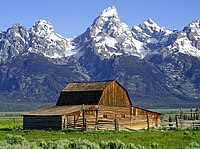
Photo from wikipedia
Abstract. We evaluated the thermal regime and relative abundance of native and nonnative fish and invertebrates within Kelly Warm Spring and Savage Ditch, Grand Teton National Park, Wyoming. Water temperatures… Click to show full abstract
Abstract. We evaluated the thermal regime and relative abundance of native and nonnative fish and invertebrates within Kelly Warm Spring and Savage Ditch, Grand Teton National Park, Wyoming. Water temperatures within the system remained relatively warm year-round with mean temperatures >20 °C near the spring source and >5 °C approximately 2 km downstream of the source. A total of 7 nonnative species were collected: Convict/Zebra Cichlid (Cichlasoma nigrofasciatum), Green Swordtail (Xiphophorus hellerii), Tadpole Madtom (Noturus gyrinus), Guppy (Poecilia reticulata), Goldfish (Carassius auratus), red-rimmed melania snail (Melanoides tuberculata), and American bullfrog tadpoles (Lithobates catesbeianus). Nonnative fish (Zebra Cichlids and Green Swordtails), red-rimmed melania snails, and bullfrog tadpoles dominated the upper 2 km of the system. Abundance estimates of the Zebra Cichlid exceeded 12,000 fish/km immediately downstream of the spring source. Relative abundance of native species increased moving downstream as water temperatures attenuated with distance from the thermally warmed spring source; however, non - native species were captured 4 km downstream from the spring. Fish diseases were prevalent in both native and nonnative fish from the Kelly Warm Spring pond. Clinostomum marginatum, a trematode parasite, was found in native species samples, and the tapeworm Diphyllobothrium dendriticum was present in samples from nonnative species. Diphyllobothrium dendriticum is rare in Wyoming. Salmonella spp. were also found in some samples of nonnative species. These bacteria are associated with aquarium fish and aquaculture and are generally not found in the wild.
Journal Title: Western North American Naturalist
Year Published: 2017
Link to full text (if available)
Share on Social Media: Sign Up to like & get
recommendations!